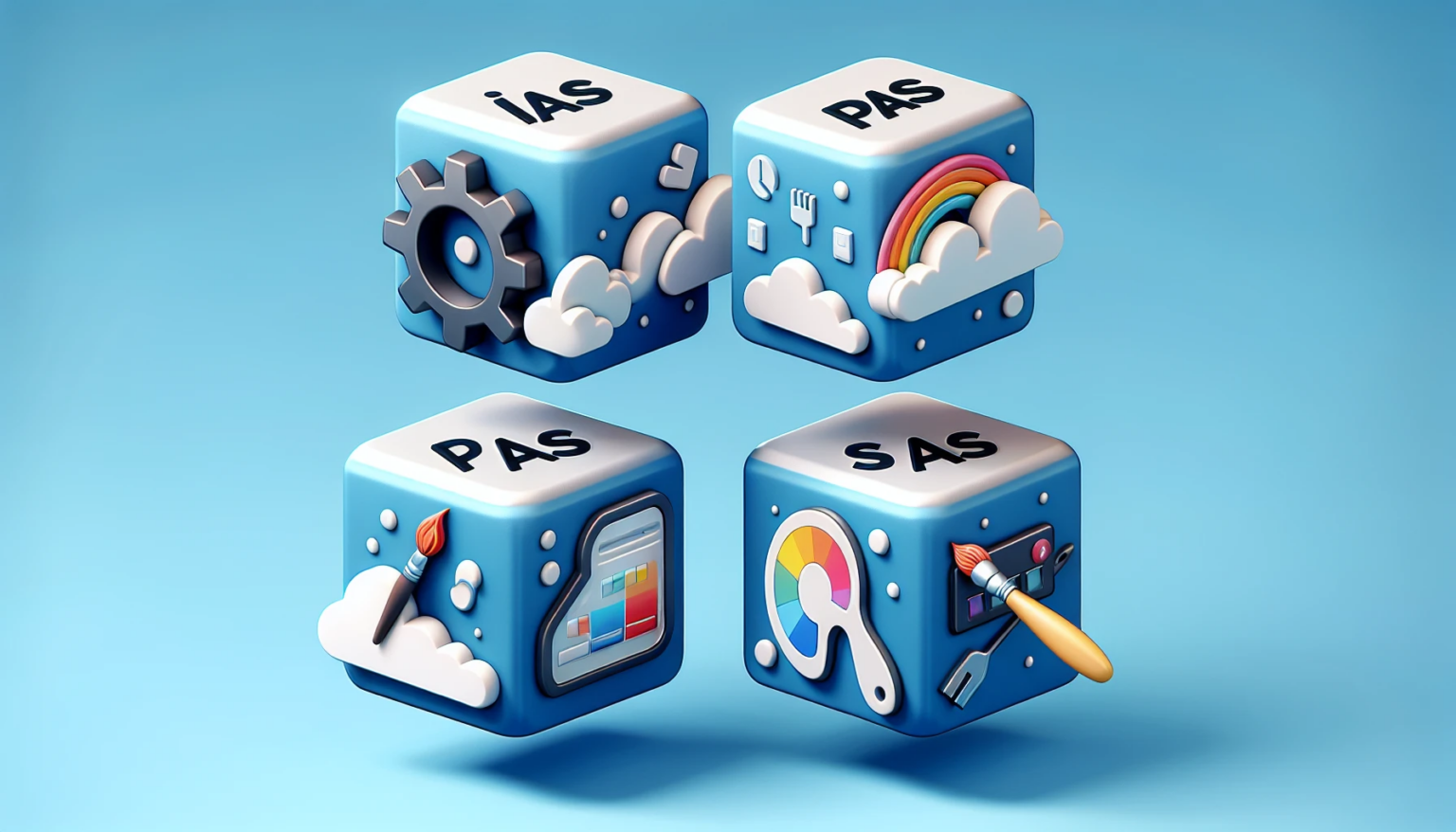The world of cloud computing offers businesses unparalleled flexibility, cost savings, and scalability. But with so many options available, how do you determine which cloud service model is the best fit for your organization? Picking the right solution is essential to maximizing the potential of your cloud strategy. In this blog post, we’ll cover the three primary cloud computing service models – Infrastructure-as-a-Service (IaaS), Platform-as-a-Service (PaaS), and Software-as-a-Service (SaaS) – and compare their key differences in an “IaaS vs PaaS vs SaaS” analysis to help you make an informed decision.
Key Takeaways
Cloud services (IaaS, PaaS and SaaS) provide businesses with on-demand resources for various operations.
IaaS provides control while PaaS offers streamlined development capabilities. SaaS is a cost-effective way to access software applications.
Security should be considered when selecting cloud service models, plus best practices must be implemented for successful implementation of strategies.
Understanding Cloud Computing Service Models

Cloud computing has revolutionized the way businesses operate, offering scalable, on-demand resources that can be accessed from anywhere. The three primary cloud service models, also known as cloud computing service models – IaaS, PaaS, and SaaS – each cater to different aspects of business operations and IT requirements.
Infrastructure-as-a-Service (IaaS) provides on-demand infrastructure resources, such as servers, storage, and networking, enabling businesses to scale and manage their IT requirements. Popular IaaS providers include Google Compute Engine and AWS EC2.
Platform-as-a-Service (PaaS) offers a platform for developers to create, deploy, and manage applications without having to be concerned about underlying infrastructure.
Software-as-a-Service (SaaS), on the other hand, provides ready-to-use software applications over the internet, which simplifies access and minimizes the need for internal IT management.
Defining IaaS: The Deep Dive
IaaS, or Infrastructure as a Service, grants businesses access to on-demand infrastructure resources, such as servers, storage, and networking. IaaS gives businesses the flexibility to purchase only the necessary components and scale them up or down as needed, presenting a cost-effective solution with reduced overhead and zero maintenance costs.
Public cloud providers such as AWS, Microsoft Azure, and Google Cloud facilitate easy access and management of data through IaaS. However, one should consider potential security issues with the provider, shared infrastructure resources, and service reliability when using the IaaS service model.
Exploring PaaS: The Developer’s Playground
PaaS, or Platform as a Service, provides developers with a framework, software, and deployment and development tools available online to facilitate the development of applications and software. PaaS allows developers to concentrate on the application’s creative aspects, freeing them from the responsibility of managing software updates, security patches, or operating system maintenance.
PaaS is particularly beneficial when multiple developers collaborate on a project, integration with other vendors is required, or custom applications need to be developed. Cloud Platform as a Service (PaaS) has many solutions available to businesses. Notable options are AWS Elastic Beanstalk, Heroku, and Red Hat OpenShift.
SaaS Uncovered: Your Software, Delivered
Software as a Service (SaaS) offers complete saas software applications that are accessible via any web browser, with the vendor responsible for the management of data, servers, and storage. Examples of SaaS applications include Google Docs and Adobe Creative Cloud. Implementing SaaS can lead to decreased expenditures in regards to software-related tasks, thus allowing technical personnel more time to focus on other matters.
Most SaaS providers use a subscription model, charging a fixed monthly fee that covers all account services. Trustworthiness is a key factor when choosing a SaaS provider.
IaaS vs PaaS vs SaaS: A Comparative Analysis

Although each cloud service model has unique benefits, understanding their key differences is key to making a sound decision. IaaS provides the highest level of control and customization, allowing businesses to manage their infrastructure resources and select their operating systems.
PaaS, in contrast, simplifies the development process by allowing developers to concentrate on creating applications without the concern of the underlying infrastructure. SaaS, on the other hand, provides ease of use and accessibility, making it a preferred choice for businesses that require software solutions without the burden of in-house IT management.
Control and Customization: IaaS at the Helm
IaaS offers users complete control over infrastructure, a high degree of customization, the flexibility to scale resources as needed, and the option to select and manage operating systems and applications. Some common applications of IaaS include disaster recovery, program testing and development, hosting complex websites, and managing big data. When choosing IaaS for a business, factors such as sturdy infrastructure, security, functionality, integration, scalability, and adherence to best practices should be considered.
However, the implementation of IaaS can lead to potential challenges like limitations in scalability, misconfiguration, provider outages, and irreversible data loss.
Streamlined Development: The PaaS Advantage
PaaS provides an efficient development and deployment environment, offering capabilities such as optimized DevOps, easy implementation of CI/CD pipelines, and support for the entire web application lifecycle. Using PaaS, developers can speed up the development, testing, deployment, and scaling of applications in a cost-effective way. PaaS typically supports application development, resource allocation, SaaS application building, cloud migration, mobile PaaS backends, API development, and management, business intelligence, and analytics.
Examples of PaaS in real-world applications include Quickbase, AWS Elastic Beanstalk, Boomi, Google App Engine, and Microsoft Azure Platform.
Ease of Use: The Simplicity of SaaS
SaaS provides businesses with convenience, enhanced collaboration, and a decreased need for IT management, as it offers software applications over the internet, requiring only an internet connection.
SaaS applications like:
Slack
ProofHub
Zoom
Trello
Google Apps
promote collaboration by offering accessible and shared data, real-time communication, and integration with other tools. Implementing SaaS can lead to decreased expenditures in regards to software-related tasks, thus allowing technical personnel more time to focus on other matters.
When adopting SaaS, one should prioritize security, master data management, and employ automation.
Market Trends: IaaS, PaaS, and SaaS Dynamics
The market adoption trends for IaaS, PaaS, and SaaS vary across different industries. However, overall, the market size for IaaS and PaaS is projected to reach multimillion USD by 2030, with a projected CAGR during 2022-2030. Infrastructure-as-a-Service (IaaS) is expected to experience the highest end-user spending growth in 2023.
While SaaS, PaaS, and IaaS are distinct, most software-focused companies utilize some form of all three. Additionally, industry cloud platforms are an emerging trend, offering customizable and pertinent industry-specific solutions.
Adoption Patterns: Who’s Leading the Cloud Race?
Google, Amazon, and Microsoft are currently the leading providers of IaaS, PaaS, and SaaS services. AWS offers an extensive range of services and apps that is unrivaled by other providers, and it continues to introduce and update its services, making it a premier choice for cloud computing.
Microsoft Azure holds a significant portion of the market and offers a wide selection of services and features that are comparable to those provided by AWS and Google Cloud.
IBM Cloud provides major Infrastructure-as-a-Service (IaaS), Platform-as-a-Service (PaaS), and Software-as-a-Service (SaaS) offerings, including cloud application services and cloud computing services.
Growth Projections: What’s Next for Cloud Services?
The projected growth rate for the global cloud services market is forecasted to be around 17.9% CAGR from 2022 to 2027. Anticipated trends in cloud computing (IaaS, PaaS, and SaaS) include:
Multi-cloud/hybrid cloud
Quantum computing
Serverless computing
Edge computing
AI integration
It is projected that the technology sector will have the highest rate of cloud service adoption in the near future. Potential economic implications of the growth in cloud services include:
Improved business agility
Cost efficiency
Opportunities for innovation and growth
The ability to dynamically scale operations without significant capital investments in infrastructure.
When to Choose Which: Practical Guidelines
The choice of the right cloud service model depends on the specific business needs and scenarios of your organization. The following are some situations where IaaS is the most practical choice:
Lean enterprises seeking a low CAPEX solution
Companies requiring scalability and rapid resource allocation
Growing businesses or projects necessitating flexibility in resource allocation
Organizations needing storage space and simplified backup processes
PaaS is well-suited for tasks such as:
API development and management
Business intelligence and analytics
Databases and data management
Application development
Big data processing and analysis
For businesses that require accessibility, functionality, and flexibility in a competitive business environment, SaaS is the go-to choice. It provides agility, cost-effective solutions, and on-demand pricing, making it a dependable option for companies.
Opting for IaaS: Scenarios and Considerations
IaaS is an ideal choice for businesses in need of complete control over their infrastructure resources and operating systems. Common applications of IaaS include disaster recovery, program testing and development, hosting complex websites, and managing big data. When selecting IaaS for a business, it is important to consider factors such as robust infrastructure, security, functionality, integration, and best practices.
However, the implementation of IaaS can pose potential challenges like scalability limitations, misconfiguration, provider outages, and irreversible data loss.
Selecting PaaS: Ideal Use Cases
PaaS is an optimal choice for developers in need of a streamlined development process and access to a platform for creating, deploying, and managing applications. Ideal use cases for PaaS include:
API development and management
Business intelligence and analytics
Databases and data management
Application development
Big data processing and analysis
Examples of PaaS in real-world applications include Quickbase, AWS Elastic Beanstalk, Boomi, Google App Engine, and Microsoft Azure Platform.
Embracing SaaS: Convenience and Collaboration
SaaS is an attractive option for businesses in need of convenience, enhanced collaboration, and a reduced need for IT management. SaaS applications such as Slack, ProofHub, Zoom, and Trello promote collaboration by offering accessible and shared data, real-time communication, and integration with other tools.
Implementing SaaS can lead to:
Decreased expenditures in regards to software-related tasks, thus allowing technical personnel more time to focus on other matters
Prioritizing security
Master data management
Employing automation
Implementing Cloud Strategies: Insights and Best Practices
For effective implementation of cloud strategies, one should prioritize:
Security
Master data management
Use automation
Adhere to cloud security best practices like data encryption, access controls, and regular security audits.
Additionally, it is beneficial to set realistic goals, learn from others’ experiences, decide on the migration strategy carefully, and never compromise on security.
Integration Tactics: Harmonizing Cloud Services
To ensure harmony between various cloud services within a business environment, middleware or integration platforms can be used, data synchronization can be implemented, security measures can be established, and integration can be monitored and managed. Cloud service integration has a positive effect on business agility and scalability, providing flexibility and the capacity to adjust resources as required.
For successful integration of cloud services in a business environment, it’s important to:
Identify integration requirements
Choose the right integration approach
Use middleware or integration platforms
Ensure data synchronization
Implement security measures
Monitor and manage the integration.
Security Considerations: Protecting Your Cloud Assets
When adopting cloud services, one should:
Plan ahead
Apply best practices for cloud security
Understand the cloud provider’s security measures and vulnerabilities
Enforce access control regulations
Be aware of the major security threats organizations face when using cloud services
Protect the network and sensitive data from cyber threats in the cloud
Evaluate the security of a cloud service before implementation
To ensure data protection in cloud computing, the following measures can be implemented:
Utilize strong encryption
Implement access controls
Regularly back up data
Select a reliable cloud service provider
Monitor and audit the cloud environment.
Cloud Computing Infrastructure: Behind the Scenes

Behind every successful cloud computing service lies a robust infrastructure composed of virtualization technology and cloud data centers. Virtualization technology allows for the creation and management of virtualized computing resources, separating services from the underlying physical infrastructure, resulting in more efficient use of hardware resources.
On the other hand, cloud data centers offer:
Data management, data storage, recovery, and backup capabilities
Support for high-volume online transactions and applications
Serve as the backbone of the cloud.
Virtualization Technology: The Engine of the Cloud
Virtualization technology is the backbone of cloud computing, allowing multiple virtual machines (VMs) to be hosted on a single physical server. This optimizes hardware resources, increases efficiency, and facilitates the efficient utilization of resources in cloud hosting services. With virtualization, resources can be easily allocated and managed with a few clicks, promoting smooth scalability and adaptability in the cloud environment.
Virtualization technology is available in several forms, including server, storage, network, and application virtualization.
Cloud Data Centers: The Backbone of Cloud Services
Cloud data centers are vital for the performance and reliability of cloud services as they supply the infrastructure and resources necessary for their delivery. Cloud data centers are expansive facilities that house computer systems, storage devices, and networking equipment, and are responsible for running applications, processing data, and guaranteeing the accessibility and security of the cloud services.
Cloud providers manage and maintain their own data centers, which are tailored to handle the scalability and flexibility demands of cloud computing. Notable cloud data centers include:
AWS
Azure
Google Cloud
Equinix
Digital Realty
QTS Realty Trust
Summary
In conclusion, understanding the distinctions between IaaS, PaaS, and SaaS is crucial when selecting the right cloud service model for your business. IaaS offers the highest level of control and customization, PaaS streamlines the development process, and SaaS delivers ease of use and accessibility. By considering your organization’s specific needs, you can make an informed decision that maximizes the potential of your cloud strategy. As cloud computing continues to evolve, staying informed on market trends and best practices will ensure that your business remains agile and competitive in an ever-changing landscape.
Frequently Asked Questions
What are the primary differences between IaaS, PaaS, and SaaS?
IaaS provides on-demand infrastructure resources, PaaS offers a platform for developers to create, deploy, and manage applications, while SaaS delivers ready-to-use software applications over the internet; thus, the primary differences between IaaS, PaaS, and SaaS are in the levels of control and customization offered.
When should a business consider using IaaS?
When scalability, rapid resource allocation, flexibility, storage space and backup processes are needed, businesses should consider using IaaS.
What are some popular PaaS platforms?
Popular PaaS solutions include AWS Elastic Beanstalk, Heroku, and Red Hat OpenShift, making it easy for businesses to quickly deploy applications and services.
How does SaaS promote collaboration among teams?
SaaS enables real-time communication and data sharing, boosting collaboration by improving teamwork and integrating with other tools.
What are the essential steps for a successful cloud integration?
To successfully integrate cloud solutions, it is important to set clear objectives, select the right model, pre-define capacity and scalability, adapt the architecture, identify long-term goals, and understand business requirements and use cases.



